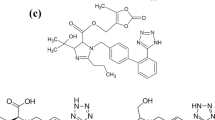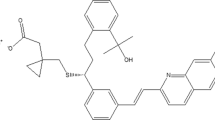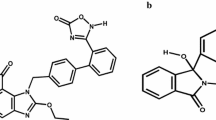Abstract
The aim of the study was to develop a new HPLC method for direct chiral separation of Ofloxacin enantiomers using polar non-aqueous mobile phase by application of response surface methodology. Rotatable central composite design (CCD) with eight factorial points, six axial points and six replications in central point was used to evaluate the influence of three independent variables (concentration of methanol, diethylamine and flow rate) on the output responses (capacity factor of first peak, tailing factors of both the enantiomers, resolution between the Ofloxacin enantiomers, retention time of the last peak and chromatographic optimization function). Further, CCD data were combined with multiple response optimization in order to obtain a set of optimal experimental conditions (% methanol/hexane/acetonitrile-43.33/10/46.62 (v/v), % acetic acid/diethylamine-0.4/0.2 and flow rate as 1.4 mL min−1) leading to the most desirable compromise between resolution and analysis time. The method demonstrated good correlation between observed and predicted responses. The developed method was validated according to ICH guidelines and applied for quantitative analysis of two commercially available tablets Zenoflox (Ofloxacin) and Glevo (Levofloxacin). Good agreement was found between the assay results and the label claim of the marketed formulations by showing good %recovery and %CV. The study resulted in a better chromatographic system for the determination of Ofloxacin enantiomers.




Similar content being viewed by others
References
Burke D, Henderson DJ (2002) Chirality: a blueprint for the future. Br J Anaesth 88(4):563–576. doi:10.1093/bja/88.4.563
Francotte ER (2001) Enantioselective chromatography as a powerful alternative for the preparation of drug enantiomers. J Chromatogr A 906(1–2):379–397. doi:10.1016/S0021-9673(00)00951-1
Drew RH, Gallis HA (1988) Ofloxacin: its pharmacology, pharmacokinetics, and potential for clinical application. Pharmacother J Hum Pharmacol Drug Ther 8(1):35–46. doi:10.1002/j.1875-9114.1988.tb0406x
Indian Pharmacopoeia (2010) vol v. 1. Indian Pharmacopoeia Commission, Ghaziabad, India
British Pharmacopoeia (2011) vol v. 1. Her Majesty’s stationery Office, London, UK
United States Pharmacopoeia (2009) vol v. 1. United States Pharmacopeial Convention, Rockville, Maryland, USA
de Boer T, Mol R, de Zeeuw RA, de Jong GJ, Ensing K (2001) Enantioseparation of ofloxacin in urine by capillary electrokinetic chromatography using charged cyclodextrins as chiral selectors and assessment of enantioconversion. Electrophoresis 22(7):1413–1418. doi:10.1002/1522-2683(200105)22:7<1413::AID-ELPS1413>3.0.CO;2-U
Awadallah B, Schmidt PC, Wahl MA (2003) Quantitation of the enantiomers of ofloxacin by capillary electrophoresis in the parts per billion concentration range for in vitro drug absorption studies. J Chromatogr A 988(1):135–143. doi:10.1016/S0021-9673(02)02015-0
Bi W, Tian M, Row KH (2011) Chiral separation and determination of ofloxacin enantiomers by ionic liquid-assisted ligand-exchange chromatography. Analyst 136(2):379–387. doi:10.1039/C0AN00657B
Yan H, Qiao F (2013) Rapid screening of ofloxacin enantiomers in human urine by molecularly imprinted solid-phase extraction coupled with ligand exchange chromatography. J Liq Chromatogr Relat Technol 37(9):1237–1248. doi:10.1080/10826076.2013.789795
Zeng S, Zhong J, Pan L, Li Y (1999) High-performance liquid chromatography separation and quantitation of ofloxacin enantiomers in rat microsomes. J Chromatogr B Biomed Sci Appl 728(1):151–155. doi:10.1016/S0378-4347(99)00085-7
Fang Z, Guo Z, Qin Q, Fan J, Yin Y, Zhang W (2013) Semi-preparative enantiomeric separation of ofloxacin by HPLC. J Chromatogr Sci 51(2):133–137. doi:10.1093/chromsci/bms117
Lehr K-H, Damm P (1988) Quantification of the enantiomers of ofloxacin in biological fluids by high-performance liquid chromatography. J Chromatogr B Biomed Sci Appl 425:153–161. doi:10.1016/0378-4347(88)80015-X
Rabbaa L, Dautrey S, Colas-Linhart N, Carbon C, Farinotti R (1997) Absorption of ofloxacin isomers in the rat small intestine. Antimicrob Agents Chemother 41(10):2274–2277
Sun X, Wu D, Shao B, Zhang J (2009) High-performance liquid-chromatographic separation of ofloxacin using a chiral stationary phase. Anal Sci 25(7):931–933. doi:10.2116/analsci.25.931
Institute. SAS (2010) JMP statistical software version 9.0. SAS Institute Inc, Cary, North Carolina, USA
Secretariat ICH (2005) Validation of analytical procedures: text and methodology, Q2 (R1), current step 4 version, parent guidelines on methodology dated November 6 1996, incorporated in November 2005, vol 60. Fed.Register, Geneva, Switzerland
Dossou KSS, Chiap P, Chankvetadze B, Servais A-C, Fillet M, Crommen J (2010) Optimization of the LC enantioseparation of chiral pharmaceuticals using cellulose tris(4-chloro-3-methylphenylcarbamate) as chiral selector and polar non-aqueous mobile phases. J Sep Sci 33(12):1699–1707. doi:10.1002/jssc.201000049
Chankvetadze B (2012) Recent developments on polysaccharide-based chiral stationary phases for liquid-phase separation of enantiomers. J Chromatogr A 1269:26–51. doi:10.1016/j.chroma.2012.10.033
Dossou KSS, Chiap P, Servais AC, Fillet M, Crommen J (2011) Development and validation of a LC method for the enantiomeric purity determination of S-ropivacaine in a pharmaceutical formulation using a recently commercialized cellulose-based chiral stationary phase and polar non-aqueous mobile phase. J Pharm Biomed Anal 54(4):687–693. doi:10.1016/j.jpba.2010.10.020
Valliappan K, Vaithiyanathan S, Palanivel V (2013) Direct chiral HPLC method for the simultaneous determination of warfarin enantiomers and its impurities in raw material and pharmaceutical formulation: application of chemometric protocol. Chromatographia 76(5–6):287–292. doi:10.1007/s10337-012-2373-7
Glajch JL, Kirkland JJ, Squire KM, Minor JM (1980) Optimization of solvent strength and selectivity for reversed-phase liquid chromatography using an interactive mixture-design statistical technique. J Chromatogr A 199:57–79. doi:10.1016/S0021-9673(01)91361-5
Sivakumar T, Manavalan R, Muralidharan C, Valliappan K (2007) Multi-criteria decision making approach and experimental design as chemometric tools to optimize HPLC separation of domperidone and pantoprazole. J Pharm Biomed Anal 43(5):1842–1848. doi:10.1016/j.jpba.2006.12.007
Choisnard L, Bigan M, Blondeau D, Dhulster P, Leman B, Guillochon D (2003) Application of the method of the experimental design to the study of a processing of unshrinkableness of wool fibers. J Appl Polym Sci 89(2):535–547. doi:10.1002/app.12173
Sivakumar T, Manavalan R, Muralidharan C, Valliappan K (2007) An improved HPLC method with the aid of a chemometric protocol: simultaneous analysis of amlodipine and atorvastatin in pharmaceutical formulations. J Sep Sci 30(18):3143–3153. doi:10.1002/jssc.200700148
Danzer K, Currie L (1998) Guidelines for calibration in analytical chemistry-Part I. Fundamentals and single component calibration (IUPAC Recommendations 1998). Pure Appl Chem 70(4):993–1014
Crowther JB (2001) Validation of pharmaceutical test methods. In: Satinder A, Stephen S (eds) Separation science and technology, vol 3. Academic Press, pp 415–443. doi:10.1016/S0149-6395(01)80014-3
Ermer J, Burgess C, Kleinschmidt G, McB. Miller JH (2005) Performance parameters, calculations and tests. In: Method validation in pharmaceutical analysis. Wiley-VCH Verlag GmbH & Co. KGaA, pp 21–194. doi:10.1002/3527604685.ch2
Acknowledgments
Sai Sandeep M is grateful to University Grants Commission (UGC), New Delhi, India, for providing UGC BSR fellowship and to UGC SAP- DRS Phase-I sponsored Department of Pharmacy, Annamalai University, Tamil Nadu, India, for providing the facilities to carry this research work.
Author information
Authors and Affiliations
Corresponding author
Rights and permissions
About this article
Cite this article
Kannappan, V., Mannemala, S.S. Multiple Response Optimization of a HPLC Method for the Determination of Enantiomeric Purity of S-Ofloxacin. Chromatographia 77, 1203–1211 (2014). https://doi.org/10.1007/s10337-014-2699-4
Received:
Revised:
Accepted:
Published:
Issue Date:
DOI: https://doi.org/10.1007/s10337-014-2699-4




